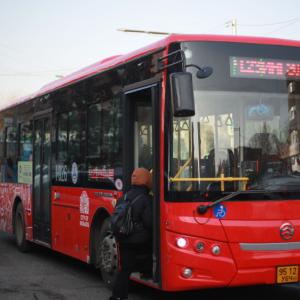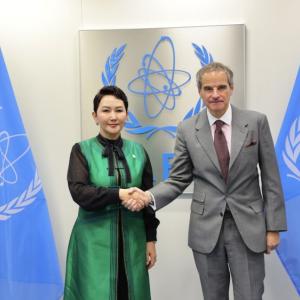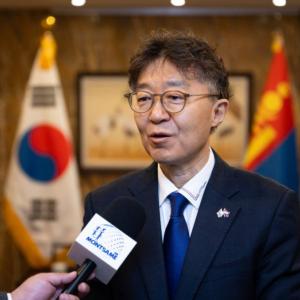Marc Tasse: Mongolia has huge potential to be a world player
The Mongol Messenger“Mongolian culture essentially falls back to its traditional nomadic civilization. I think, one of the best things about Mongolia is that it hasn’t disappeared. That would be the biggest loss if Mongolia loses its tie to the countryside and the steppe”, says Canadian national Marc Tasse, 51, who shares his relationship with and feelings about Mongolia in this interview. He is currently working as Resident Director of American Center for Mongolian Studies (ACMS) and Secretary-General for Project Management Institute (PMI) Chapter Mongolia.
Roughly 4 years ago, he was offered a six-month contract to do business assessment at the ACMS Mongolia Office after which he stayed to actually deliver his recommendations. Marc has lived in Mongolia since March, 2013, and has no plan of leaving the country in the near future.
A perfect welcome ceremony
Marc says he knew very little about Mongolia when he was approached about it 4 years ago. So he asked for a week to learn about Mongolia and make his mind. “It just so happens that around that time, I was introduced to Anne Biolik, former Canadian Ambassador to Mongolia at a lunch meeting. She was very enthusiastic about the potential and growth in Mongolia. So I accepted the position”, he said. “I also did some research and part of me was expecting Mongolia to be very similar to other Asian nations where I worked in the past. But I quickly learned that Mongolia is very unique”, he said. He has lived and worked in Asian nations like the Republic of Korea, Thailand, Japan and China.
And today, his relations with Mongolia keep getting stronger as he gets more involved in local organizations and projects. “Part of me is invested in seeing Mongolia’s growth and success. I am focusing on capacity building, working with Mongolians and Mongolian companies to make them more independent and self-sustainable and less dependent on foreign help”, he said.
“I think there’s a huge potential for Mongolia to be a world player. There’s just a little bit of time they need to build on that capacity”, Marc shares his positive expectations for Mongolia.
When asked to recall his first day in Mongolia, he answers, “I landed in Mongolia in a slightly cold afternoon. The new airport highway or Hunnu Mall hadn’t been constructed then. After 15-20 minutes down the old road from the airport, the traffic was stopped, and a herd of horse just ran across the highway. It was probably a hundred horses. Looking at that scene and since I like to ride horses, I thought, ‘I am going to like this place’. The bright blue sky, the white mountains and someone driving hundreds of horses across the highway; it was a perfect introduction to what Mongolia was going to become”.
Increasing visibility and accessibility
As Marc is heading an organization that focuses on Mongolian studies, our discussion proceeded with the study of Mongolia and ACMS which is a part of the Council of American Overseas Research Centers, and supports academic research and academic research projects about Mongolia.
“A lot of what’ve done, especially in the last 4-5 years has been really promoting an awareness of Mongolia as a good place to conduct research, and that there’s a lot of opportunities for learning and sharing. I think, that is one of the big things that is increasing the visibility of Mongolia in places like Berkeley where a Mongolian studies department has been running for the last two years. We’ve been attracting a lot of interest in Mongolian studies at the Pennsylvania University. We also have a group that comes to Mongolia yearly from Western Washington University with whom we have a library development program. We work with these types of projects a lot. Indiana University is the strongest classical Mongolian studies institution in the US, and they are still going very strong”.
“Harvard University has always had classic Mongolian studies, but recently they’ve started focusing on their Mongolia Health Initiative through which Harvard researchers come and conduct researches in Mongolia in a field office based in Ulaanbaatar. On the other hand, there is interest in establishing an Institute of Mongolian Studies at the Harvard, the process is in the initiation stages”, he shared.
According to Marc, there are many new universities and institutions that the ACMS is working with on researches in and about Mongolia.
“The other thing we’ve been working on is partnerships between Mongolian researchers and foreign researchers. We are working on helping Mongolian researchers structure and submit articles for publication, do joint publications and ask for joint publication rights, so that Mongolian researchers get recognition for their work. We also help them apply for presentations for different congresses and conferences around the world, so that people start seeing Mongolians as the experts of what’s happening here within the country”.
 Marc assesses that there’s an increasing interest in doing research in Mongolia. “We are seeing more applicants for our grants and programs where people want to come to Mongolia to do research on wide variety of different subjects because Mongolia is becoming more visible and accessible. Moreover, it is becoming easier for researchers to be able to conduct research. The environment for young researchers to conduct is much more positive, open and easier now”, he explains.
Marc assesses that there’s an increasing interest in doing research in Mongolia. “We are seeing more applicants for our grants and programs where people want to come to Mongolia to do research on wide variety of different subjects because Mongolia is becoming more visible and accessible. Moreover, it is becoming easier for researchers to be able to conduct research. The environment for young researchers to conduct is much more positive, open and easier now”, he explains.
Why inquire into Mongolia?
“I think, Mongolia is an excellent study material for multiple reasons”, Marc states.
“One of the main advantages for researchers is that Mongolia is isolated. In Mongolia, researchers can get very good results for empirical research. Mongolia is very interesting because you can easily isolate the variables within your research”.
“Secondly, it is the pace of change in Mongolia. Things change and develop very quickly in Mongolia compared to other places because it’s a small, isolated population. Researchers can come in, do research, and instead of having to wait 5-15 years like in most of the places, they can actually see measurable change in less than 5 years because Mongolia is one of those quick adapters. It’s quick to accept, modify and work with new ideas and technologies that come in”.
Marc then identified reasons that could motivate one to study about Mongolia. “Mongolia is an interesting and wonderful place. There’s the whole history of the Mongol people and the global influence Mongolia’s had. If you look at the last 2000 years, Mongolia’s had huge influences on not only the developments in Asia, but also development of Europe and Central and Middle East. There are those applications that make Mongolia interesting”.
Mongolia can also be studied environmentally and economically, he adds. “For example, the decrease in demand for raw materials and resources for a manufacture in China because of economic slowdown, it affected other countries, but it has been magnified in Mongolia. Mongolia is a sort of an indicator economy, country or environment, making it very interesting to study. Because then you can extrapolate from what happens here what could be going on globally”.
Marc’s third reason to study Mongolia is that there hasn’t been much research that’s been done. “One of the hardest things for a researcher is finding a new idea or a new subject to study. Mongolia offers a lot of stuff that hasn’t been looked at such as environmental issues, economic growth, evolving modern culture, change of society mindset, lifestyle comparison and its transition from socialism to democracy in the last 25 years. There are many interesting aspects such as the huge generation divide in Mongolia of the over 40s and under 40s and their attitude, mentality, work ethic and values; one can find many great differences. These are all open for researchers to study and come up with new ideas and theories”.
Marc also says, even the fact that Mongolia exists is something to study. “With China and Russia on each side, one of which could have swallowed Mongolia, how has Mongolia been able to play its diplomacy successfully, and managed to stay under the radar? That in itself is a tribute to the people and something that should be studied. There’s a lot of stuff here that the world can learn from”.
I am just as important as you
Our interview proceeds to Marc’s experience of living in Mongolia as the agenda is essential and natural with foreigners in Ulaanbaatar.
“Ulaanbaatar is a very easy city for an expat, for example, I walk to 80 percent of my errands. I also appreciate the quick pace of evolution of Ulaanbaatar during my 4-year stay such as the diversity and changes in restaurants and entertainment that’s available. The quality of food and stuff found at supermarkets are about the same as what you can get in North America or Europe. Pricing is average or cheaper. The worst part is air quality in winter, but it is three months. Aside from those three months when you can’t breathe, it’s fine”, he shares his opinion of the capital city.
“I love Mongolian food in the countryside, and don’t like Mongolian food in Ulaanbaatar. When we are out in the countryside, we get real Mongolian food from gers and families in there. It’s regular Mongolian dishes like buuz, tsuivan and huushuur, but it definitely tastes better in the countryside where also good airag, curd and milk are found”, he says. Marc has been to 7-8 aimags including Khentii, Selenge and Khuvsgul. “I love the diversity of landscape in Mongolia. The environment of Mongolia is what captures most of the expats when they come here, the raw nature and beauty of what Mongolia is”, he conveys.
Marc says he gets along very well with Mongolians, and he appreciates their honesty and openness. “They are not afraid to speak their mind regardless they are old and young. They tend to be very open and honest with their expressions and feelings about what’s happening. And to me that’s refreshing because everybody is trying to be so politically correct”, he explains.
“And there’s inner confidence almost bordering with arrogance in Mongolians. For example, there is a trilateral meeting of Presidents of Mongolia, China and Russia, and the Mongolian side has an attitude that they are the same. We are talking about leaders of two most powerful nations in the world with Mongolia in the middle, but no, ‘we are the Presidents of our countries, we are the same and we should be treated with same level of respect’. And it’s not in an arrogant way; it’s just of ‘this is the way we are’. This is just not in politics, you see this in people. People expect to be respected for who and what they are, and not because of their position or money, but for a reason ‘why am I any different than you’. I love that ‘I am a person just as important as you, so treat me with equal respect’ attitude of Mongolians”, Marc makes out his opinion with an interesting example.
He then compares Mongolian society with that of others saying, “Mongolia is very difficult to classify. Some things about Mongolia are Asian, some not, some European and western and some not. It’s not just from influences, but in behavior such as the relationships between men and women. Mongolian women are very different than other Asian women; they are not subservient or obedient. They are better educated and more outspoken; they are not afraid to make decisions, take the lead and make things happen. There’s not a strong hierarchy in people-to-people relations. There’s a respect for the elders and seniors, but everybody underneath is more or less the same. So those are very different things that I see in Mongolia. I think those are great things and part of what’s made Mongolia strong. I think, it comes from the nomadic culture”.
“To me, what differentiates Mongolians from other Asians and Europeans is strong sense of independence of being reliant on themselves and not bowing down to anyone because they are as good as everybody else”, he adds.
Marc also explains the uniqueness of Mongolia saying, “I don’t think there’s anywhere else in the world that behaves like Mongolia, that becomes very apparent to people. But I also worry about influences from other countries on the younger generation. It will be interesting to see how Mongolia manages these outside influences, adapt to it, and make it Mongolian which I am sure they will”.
Kh.Aminaa
Photo by B.Chadraabal
The article first appeared in the Mongol Messenger's issue No. 11 for March 17.
 Ulaanbaatar
Ulaanbaatar













































































